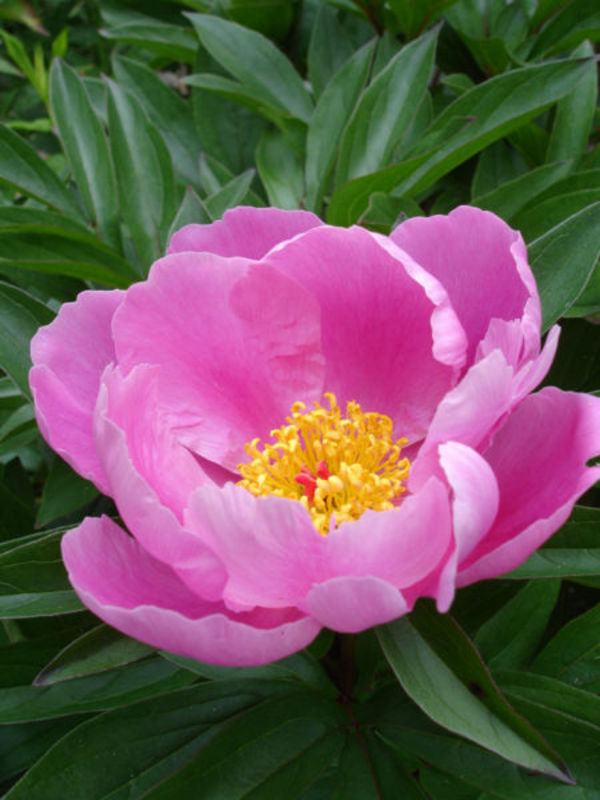
Common Name: Peony | Scientific Name: Peonia Albaflora

Family Name: Ranunculaceae
Introduction
The peony plant in the west is seen as a flowering plant; in Asia, it is seen as the source of a life force building tonic with special usefulness amongst women. Definetly a vitality blaster that should be added to the arsenal of staying well.
Resources
Fact Sheet
Fact Sheet
Part Used: Root
Principal Use: Female reproductive tract pain
Principle Action: Cramp killer
History and Traditional Use
The Peony is indigenous to China, but was imported to Japan so early it is difficult to be certain when the transplantation occurred. It is a perennial plant with flowers of white, red or pink which are born in late spring.
The peony was originally introduced as medicine. Indeed, its ancient Japanese name “Ebisugusuri” literally means ‘medicine from China’. However, due to its beautiful blooms, in time, many decorative varieties were developed. In Japanese society, it was seen both as a medicine and a source of beautiful blooms.
In traditional Japanese medicine peony root is seen as being a must in the medicine chest. It is used to soothe menstrual cramps, indeed for all sorts of pain issuing from the female reproductive tract.
This use, like the plant itself, comes from China. The oldest Chinese herbal, “Shinnouhonzoukyou” (Divine Husbandmans’ Classic of the Material Medica) written about 2100 years ago mentions it as relieving abdominal pain, abnormal sensations in the abdomen, sharp pains, and colicky pains. In short, the kind of pain women experience! To this day, it is a very important drug in Traditional Chinese Medicine. It is a mainstay in the treatment of female problems- specifically used to alleviate pain and muscle cramps. Traditional Chinese medicine holds that it calms the spirit which may explain why it is used to treat women suffering from PMT.
The Science of Peony
Chemical Constituents
Glucosides: paeoniflorin, oxypaeoniflorin, albflorin, benzoylpaeoniflorin. Monoterpenes: paeoniflorigenone, paeonilactone A, B, C, β -pinen-10-yl vicanoside, lactiflorin. Mucilage. Volatile oil. Saccarides. βsistosterol, Benzoic acid, Gallotannins
Cramp Killer
A newly discovered monoterpene, paeoniflorigenone, was found to block transmission of cramp impulses from nerve endings to reactor muscles. The implication being Peony blocks cramps.
In animal experiments, paeoniflorin was found to be anti-convulsive, anti-spasmodic, sedative, anti-inflammatory, analgesic, hypothermic, and a smooth muscle relaxant. In a word, it was found to be a powerful menstrual cramp cure.
Practitioner Recommended Use for Paeony
Peony is especially helpful for women experiencing menstrual pain and cramping. It relaxes the uterus and reduces the strength of contractions. For women who experience severe cramping, there could be no better treatment than peony.
Bibliography
• James Duke, Medicinal Plant of China, p533-534, 1985
• Kun-Ying Yen, The Illustrated Chinese Materia Medica, SMC Publishing INC., p51-52
• W. Tang, G. Eesenbrand, Chinese Drugs of Plant Origin, Springer Verlag, p703-708, 1992
• Kee Chang Huag, The Pharmacology of Chinese Herbs, CRC Press, p267, 1999
• Kazuo Izawa, Color Encyclopedia of Medicinal Herbs, Shufunotomo-sha, p191, 1998
• Dan Bensky and Andrew Gamble, Chinese Herbal Medicine Materia Medica, Eastland Press, P398-399, 476-477, 1986
• Ko utarou Murakami, Herbal Remedy, Houken, p161, 1995
Eclectic Notes
1874: Scudder
Preparation – Prepare a tincture from the fresh root of the garden peony, in the proportion of 3viij. to Alcohol 76 degree Oj. Cose from drops gtts. v. to 3ss.
This remedy has been but little used, yet the evidence is pretty conclusive that is possesses a marked influence upon the nervous system. It has been employed as an antispasmodic, and to relieve irritation of the nerve centers. Will some of our friends prepare a tincture in the summer and test it?
Disclaimer: The author makes no guarantees as to the the curative effect of any herb or tonic on this website, and no visitor should attempt to use any of the information herein provided as treatment for any illness, weakness, or disease without first consulting a physician or health care provider. Pregnant women should always consult first with a health care professional before taking any treatment.
